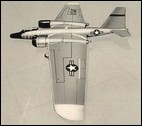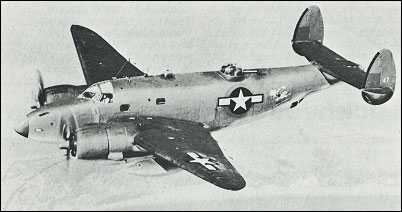LATEST COMMENTS
11.08.2025 13:14

Boeing Model 74 / XF3B-1 11.08.2025 08:25

Loire-Nieuport L.N.40 / L.N.401 / L.N.411 11.08.2025 02:01

09.08.2025 21:44

09.08.2025 18:10

08.08.2025 19:50

08.08.2025 17:21

Canadair CL-44 "Forty Four" 06.08.2025 13:47

Bristol 175 Britannia 05.08.2025 03:46

04.08.2025 23:33

Pemberton-Billing (Supermarine) P.B.31E 04.08.2025 14:12

03.08.2025 23:57

03.08.2025 22:33

Loire-Nieuport L.N.161 03.08.2025 21:54

Short S.23 Empire 31.07.2025 23:19

31.07.2025 04:07

Yakovlev Yak-28 30.07.2025 00:38

Junkers Ju 390 29.07.2025 00:33

26.07.2025 13:48

25.07.2025 11:11

23.07.2025 19:36

Boeing XP-7 / Model 93 22.07.2025 05:52

Scottish Aviation (Prestwick) Pioneer 22.07.2025 01:36

21.07.2025 15:57

IAI-101, 102, 201 "Arava" 19.07.2025 21:11

Curtiss Eagle 15.07.2025 17:19

14.07.2025 00:48

Vickers Valetta 12.07.2025 14:21

BAC.111 One Eleven 11.07.2025 22:06

11.07.2025 06:53


|
 | Anonymous, 05.09.2022 18:26 "...and was built for the US Army Air Force and US Navy..." Actually, only a handful of Venturas were ever accepted by the Army Air Force because an agreement was reached in which all of the Venturas were to be turned over to the Navy for use as patrol bombers. It is a little-remembered fact that, starting in January 1944, Navy Venturas based in the Aleutian Islands carried out a bombing campaign against targets in Northern Japan. At least 11 Venturas are known to have landed in Russian territory when they became too badly damaged to return to the Aleutians. Since the Soviet Union was neutral with regards to Japan, the crews had to be "interned". However, they were quietly repatriated back to the U.S. via Iran. Nevertheless, the Soviets kept the Venturas, several of which the Red Air Force repaired and used operationally.
| | Buddie Jordan, e-mail, 25.05.2016 05:00 Dave Patterson was too modest to tell about his saving a PV-2 in a Dublin Georgia thunderstorm when sudden rain deluge forced a go-around on instruments... a split flap condition almost rolled them inverted but Dave recognized what was happening and lowered flaps enuf to regain control.
| | Patrick Menichino, e-mail, 18.01.2016 20:06 My dad "Ben Menichino" flew with VPB 198, 1944-45. He was a turret gunner. He was stationed at NAS Norfolk, Lake City, Beafort SC, and Moffit CA. He was discharged in 1945 with broken eardrums. I would like to know what other squadrons he was with? Pat
| | Gil Bliss, e-mail, 06.06.2015 21:42 PV-2D was my first Navy ride. I retired with P-3's
| | Clark Wolf, e-mail, 08.07.2014 06:21 My dad was a 17 year old, reconnaissance photographer / tail gunner, in a PV-2. He was in the South Pacific and joked that when they would bomb a Japanese submarine he sometimes ended up with a picture of a whale with a big headache. Not very PC now, but in those tough time I can see the grins and groans this would have brought.
| | Dave mills. Warren mills, e-mail, 30.10.2011 04:15 My dad flew this plane in 1944 and says it is a 4000hp beast and would pass a corsair at 5000 ft
| | Klaatu, e-mail, 10.07.2011 18:43 While the Boeing B-29s of the 20th AAF were attacking Japan from the Mariana islands, a little-publicized bombing campaign was also being carried against Japan by aircraft of this type, operating from bases in Alaska's Aleutian Islands.
| | Patrick Dorcy, e-mail, 26.05.2011 00:26 Patrol Bomber out of Carribean as a aircraft commander VPB-141
| | bombardier, e-mail, 22.05.2011 12:44 The Ventura was one of the best medium bombers of the war.It was fast and manouverable.It is considered a failure because the British used it in the wrong way,no aircraft can survive attacking targets deep into enemy territory unescorted. This stupid strategy also doomed several other excellent aircraft
| | Harry Gribbon, e-mail, 28.03.2011 20:15 In the Navy in 1945, I flew in the PV-1 out of Lake City Florida as the mid-upper-deck turret gunner. From my view, I had an opportunity to watch the twin tail assembly twisting right and left; always somewhat disconcerting. My first flight was to practice evasive maneuvers. Our tail gunner found out the hard way you had to force your white hat with the barf through the small round deck port and not just drop it into the open port where it would bounce right back at you.
| | Darrell Meldrum, e-mail, 15.03.2011 18:46 My favorite was the 500 it would come in to La Porte TX. for inspections when it was coming we would rebuild the jacks for retractions because it was so heavy the last time i got to change 4 jugs on the bottom of course wish i could do again good time in my life last bird i flew on as crew was C130A Flt. engineer another master piece
| | mike grieco, e-mail, 06.03.2011 06:40 Like the gentleman before me, I also had the pleasure of flying these wonderful Howard conversions of the LB-34 and the Navy version PV-1 and PV-2. Most of my time was spent in the H-400 (N2ES) there were only 10 or 11 ever built, it was the prototype of the H-500. The main difference in the two aircraft was the H-400 had shorter or clipped wings than the H-500 which gave it a higher true airspeed. I flew this aircraft approx. 1200 hours and enjoyed every minute of it. It would hold a sea level cabin to 16,000' and I would flight plan it at 340mph@ 16,000'. Few people no about these aircraft and I feel priveledged to have spent some time with these airplanes. Thank you Mr. Hughes.
| | michael smith, e-mail, 24.01.2011 00:10 great plane.used by the naval reserve in norfolk va. in the 50,S--PV2
| | Kenneth St John, 19.11.2010 03:49 There is an excellent account of the role of the PV-1 during the WW2 campaign in the Aleutians and the Japanese held Kuril Islands, written by Ralph Wetterhahn, and titled "The Last Flight of Bomber 31" (2004).
| | Bruce Fuhr, e-mail, 25.10.2010 05:15 California-1943: My brother was drafted, Momma worked at VEGA (Lockheed)A/C on B-17s. I quit Canoga Park High, went to work at VEGA,B-17 Final Assem. Being only 16 years old, Max.Hrs was 44hrs/wk. But; I always worked overtime on PV-1s & then PV-2s. A tight airplaine to move around in. Got drafted, Infantry. Aboard Troop ship "Seafiddler in the Pacific, "PTO",On the way to Philippines, It ran aground by New Guinea, Jap Sub waters. From nowhere came a PV-1. Lower than the main deck. we looked down as it was flying by. The Pilot waived. You could read the time on his wristwatch. Gawd; were they close. Could've reached down and touched the wing. That PV-1 sounded and looked beautiful. Their P&Ws churned up the water behind them. We sure felt safe now. Two days prior we were almost torpedoed. (The P-2Vs had larger Stabilizers) Bruce Fuhr.... Not: "Der Fuhr"
.
| | alex, e-mail, 12.10.2010 21:43 its perfect but the extra cockpit added a little more drag.
| | alex, e-mail, 12.10.2010 21:41 its perfect but the extra cockpit added a little more drag.
| | DAVID PATTERSON, e-mail, 07.03.2010 23:15 Used to fly a PV-2 out of Dothan, AL to spray fire ants back in the late 60's. Dothan Aviation also had three B-17s and several Douglas B-25s. Have photos if interested. DP
| | JERRY THOMPSON, e-mail, 31.01.2009 06:26 I had the distinct pleasure of flying Howard 350 N350K during 1964-65. I then went on to the major airlines and flew DC-8,DC-9,B-727,AIRBUS A-300, and Lockheed 10ll. to this day, my favorites to fly were the HOWARD 350, T-28,
B-727,& L-1011.
The 350 cruised at 312 mph at 12000ft, 57% power.
| | Joe Moore, e-mail, 07.01.2009 02:03 I flew the Howard 350 conversion of the PV-1 /B-34 - M200JW Tail Number. lockheed. Some had the Horton/ Horton interiors. Large picture windows. Nothing Like the purr of the twin R-2800's and the four bladed Hamilton Stardard square tipped props. I think they were revamped Connie props. Also Flew the Howard 250 Tri-gear L-18 conversion N250W and the Learstar L-18. The Nose gear was supposedly from the WW11 B-26 airplane. It was steerable from the center console and had it's own disc brake that we later removed because of the heavy loads it imposed on the nose gear strut assy. when braking. We cruised Howard 350 at 305 MPH.
Joe Moore
|
Fatal error: Uncaught Error: Undefined constant "isMob" in /data03/virt15346/domeenid/www.aviastar.org/htdocs/comments/comments.php:165
Stack trace:
#0 {main}
thrown in /data03/virt15346/domeenid/www.aviastar.org/htdocs/comments/comments.php on line 165
|





























